Marketing Essentials Report: Coca-Cola's Marketing Strategies and Mix
VerifiedAdded on 2020/10/22
|10
|3003
|300
Report
AI Summary
This report delves into the marketing strategies employed by Coca-Cola, a globally recognized brand. It begins by outlining the essential roles and responsibilities of marketing functions within an organization, emphasizing their significance in understanding customer preferences, influencing buying behavior, and achieving business growth. The report then examines how these marketing functions interrelate with other departments, such as Human Resources, Finance, Production, and Customer Service, to achieve overall organizational goals. Furthermore, it analyzes Coca-Cola's application of the marketing mix (product, price, place, promotion, people, process, and physical evidence) and compares it to that of its competitor, Pepsi. The report highlights the importance of marketing in supporting the transfer of goods, creating employment, generating income, and fostering new ideas, while also considering market segmentation, pricing strategies, distribution channels, and after-sales services. This comprehensive analysis provides insights into the marketing practices that have contributed to Coca-Cola's success in the competitive beverage industry.
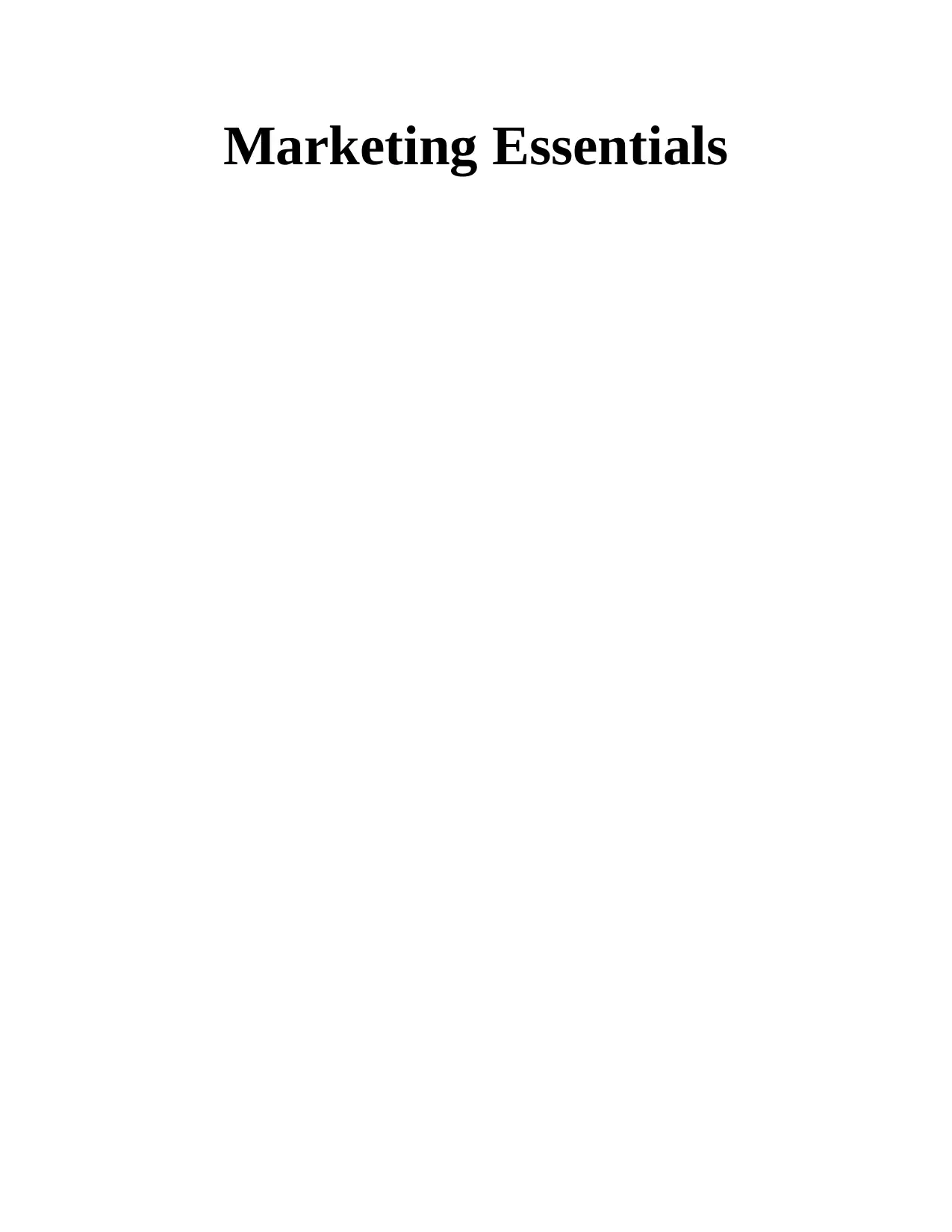
Marketing Essentials
Paraphrase This Document
Need a fresh take? Get an instant paraphrase of this document with our AI Paraphraser
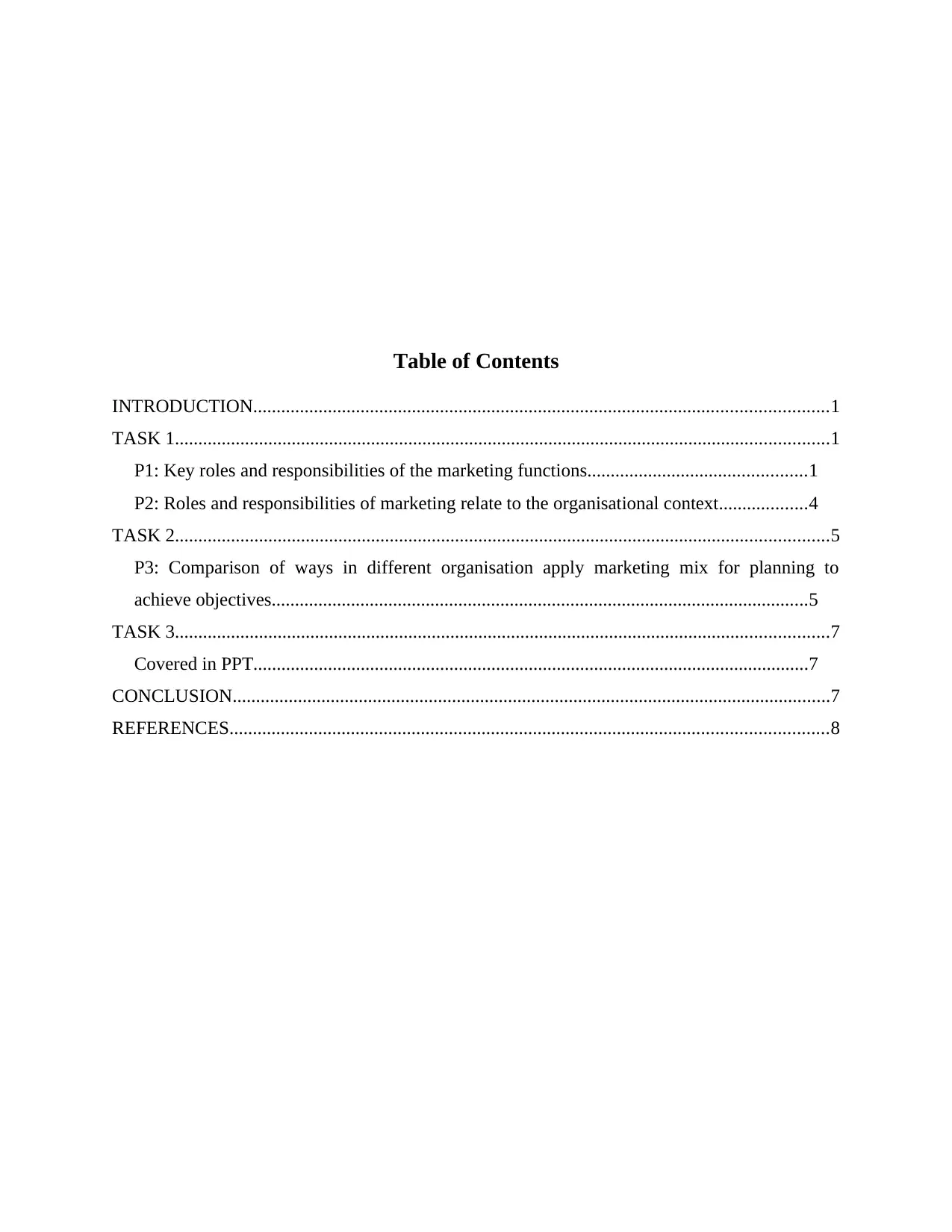
Table of Contents
INTRODUCTION...........................................................................................................................1
TASK 1............................................................................................................................................1
P1: Key roles and responsibilities of the marketing functions...............................................1
P2: Roles and responsibilities of marketing relate to the organisational context...................4
TASK 2............................................................................................................................................5
P3: Comparison of ways in different organisation apply marketing mix for planning to
achieve objectives...................................................................................................................5
TASK 3............................................................................................................................................7
Covered in PPT.......................................................................................................................7
CONCLUSION................................................................................................................................7
REFERENCES................................................................................................................................8
INTRODUCTION...........................................................................................................................1
TASK 1............................................................................................................................................1
P1: Key roles and responsibilities of the marketing functions...............................................1
P2: Roles and responsibilities of marketing relate to the organisational context...................4
TASK 2............................................................................................................................................5
P3: Comparison of ways in different organisation apply marketing mix for planning to
achieve objectives...................................................................................................................5
TASK 3............................................................................................................................................7
Covered in PPT.......................................................................................................................7
CONCLUSION................................................................................................................................7
REFERENCES................................................................................................................................8
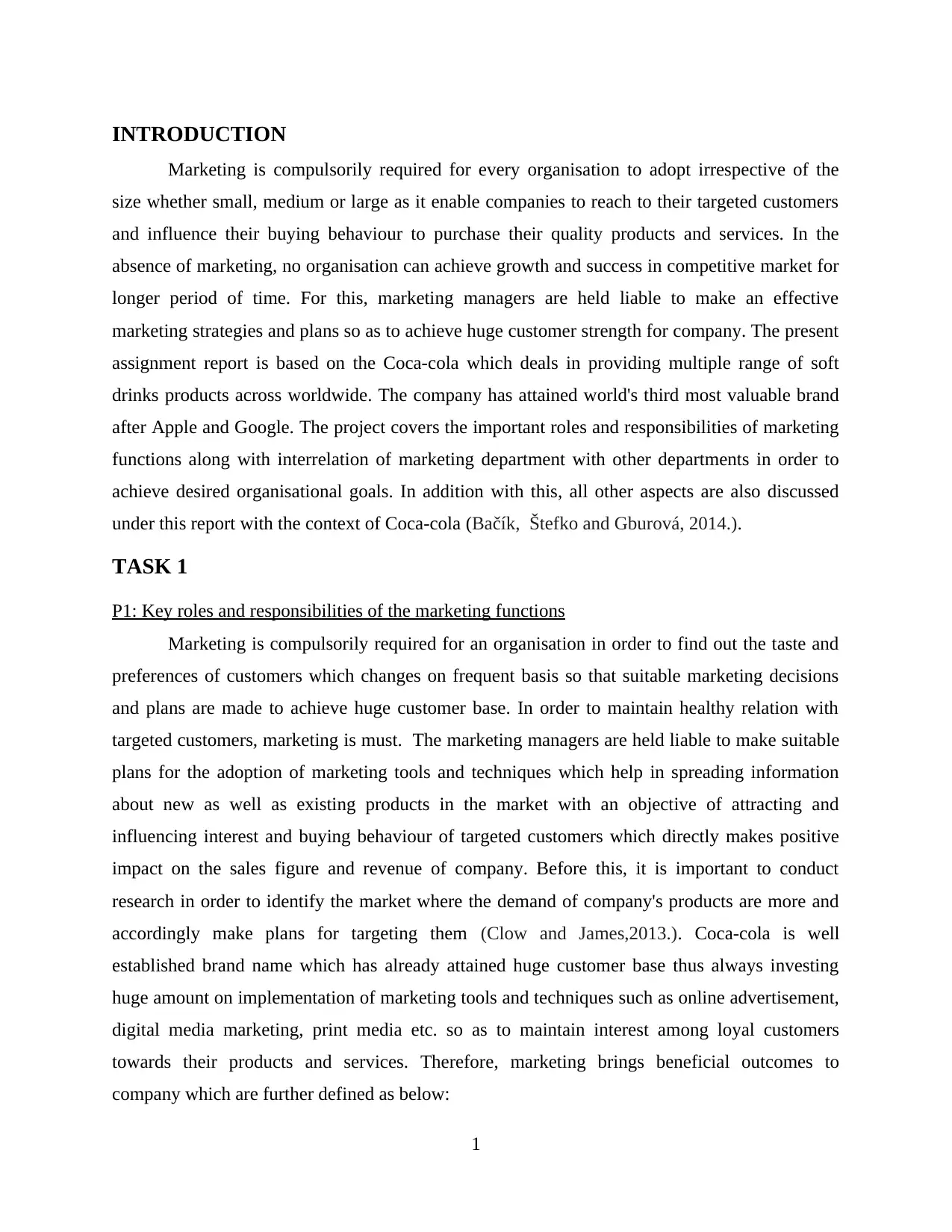
INTRODUCTION
Marketing is compulsorily required for every organisation to adopt irrespective of the
size whether small, medium or large as it enable companies to reach to their targeted customers
and influence their buying behaviour to purchase their quality products and services. In the
absence of marketing, no organisation can achieve growth and success in competitive market for
longer period of time. For this, marketing managers are held liable to make an effective
marketing strategies and plans so as to achieve huge customer strength for company. The present
assignment report is based on the Coca-cola which deals in providing multiple range of soft
drinks products across worldwide. The company has attained world's third most valuable brand
after Apple and Google. The project covers the important roles and responsibilities of marketing
functions along with interrelation of marketing department with other departments in order to
achieve desired organisational goals. In addition with this, all other aspects are also discussed
under this report with the context of Coca-cola (Bačík, Štefko and Gburová, 2014.).
TASK 1
P1: Key roles and responsibilities of the marketing functions
Marketing is compulsorily required for an organisation in order to find out the taste and
preferences of customers which changes on frequent basis so that suitable marketing decisions
and plans are made to achieve huge customer base. In order to maintain healthy relation with
targeted customers, marketing is must. The marketing managers are held liable to make suitable
plans for the adoption of marketing tools and techniques which help in spreading information
about new as well as existing products in the market with an objective of attracting and
influencing interest and buying behaviour of targeted customers which directly makes positive
impact on the sales figure and revenue of company. Before this, it is important to conduct
research in order to identify the market where the demand of company's products are more and
accordingly make plans for targeting them (Clow and James,2013.). Coca-cola is well
established brand name which has already attained huge customer base thus always investing
huge amount on implementation of marketing tools and techniques such as online advertisement,
digital media marketing, print media etc. so as to maintain interest among loyal customers
towards their products and services. Therefore, marketing brings beneficial outcomes to
company which are further defined as below:
1
Marketing is compulsorily required for every organisation to adopt irrespective of the
size whether small, medium or large as it enable companies to reach to their targeted customers
and influence their buying behaviour to purchase their quality products and services. In the
absence of marketing, no organisation can achieve growth and success in competitive market for
longer period of time. For this, marketing managers are held liable to make an effective
marketing strategies and plans so as to achieve huge customer strength for company. The present
assignment report is based on the Coca-cola which deals in providing multiple range of soft
drinks products across worldwide. The company has attained world's third most valuable brand
after Apple and Google. The project covers the important roles and responsibilities of marketing
functions along with interrelation of marketing department with other departments in order to
achieve desired organisational goals. In addition with this, all other aspects are also discussed
under this report with the context of Coca-cola (Bačík, Štefko and Gburová, 2014.).
TASK 1
P1: Key roles and responsibilities of the marketing functions
Marketing is compulsorily required for an organisation in order to find out the taste and
preferences of customers which changes on frequent basis so that suitable marketing decisions
and plans are made to achieve huge customer base. In order to maintain healthy relation with
targeted customers, marketing is must. The marketing managers are held liable to make suitable
plans for the adoption of marketing tools and techniques which help in spreading information
about new as well as existing products in the market with an objective of attracting and
influencing interest and buying behaviour of targeted customers which directly makes positive
impact on the sales figure and revenue of company. Before this, it is important to conduct
research in order to identify the market where the demand of company's products are more and
accordingly make plans for targeting them (Clow and James,2013.). Coca-cola is well
established brand name which has already attained huge customer base thus always investing
huge amount on implementation of marketing tools and techniques such as online advertisement,
digital media marketing, print media etc. so as to maintain interest among loyal customers
towards their products and services. Therefore, marketing brings beneficial outcomes to
company which are further defined as below:
1
⊘ This is a preview!⊘
Do you want full access?
Subscribe today to unlock all pages.

Trusted by 1+ million students worldwide
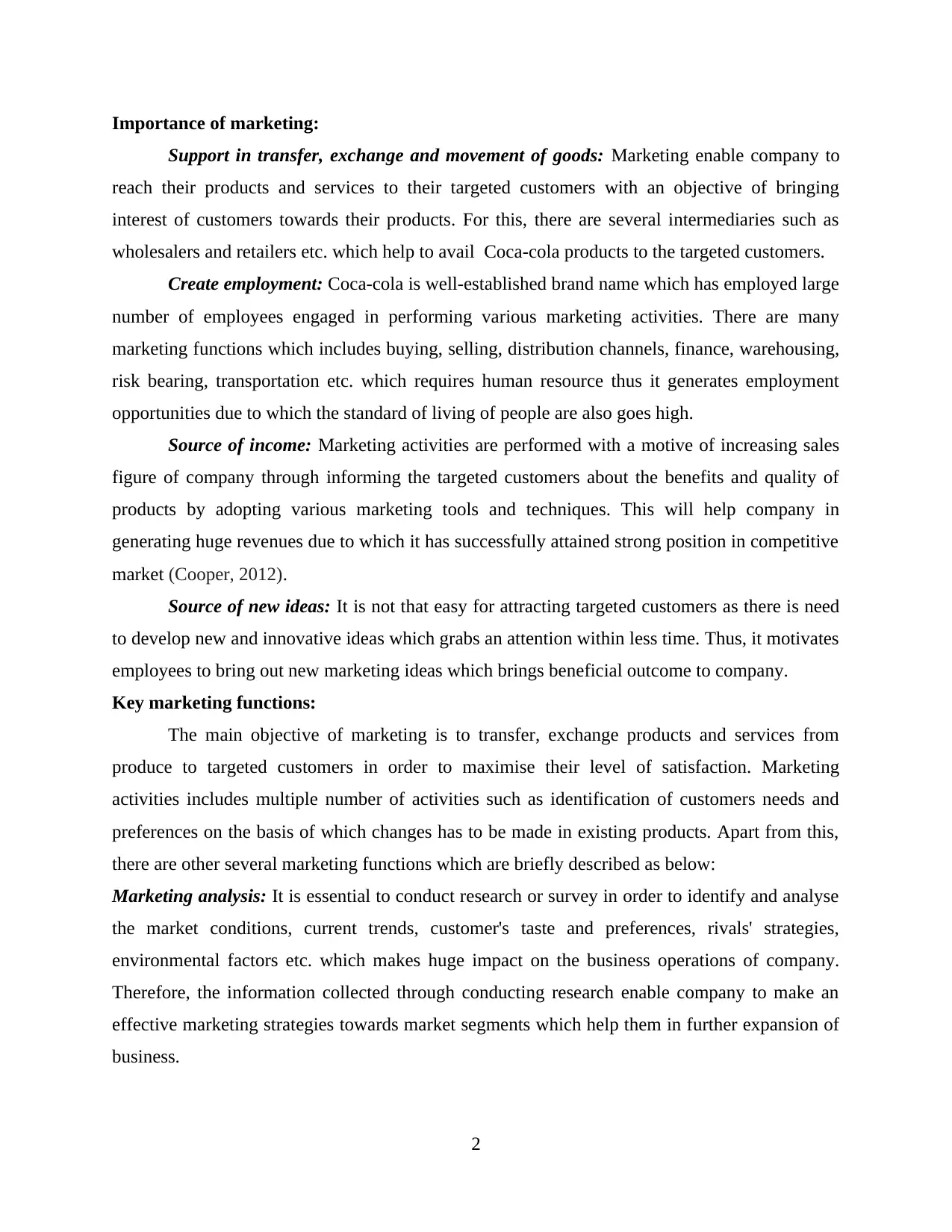
Importance of marketing:
Support in transfer, exchange and movement of goods: Marketing enable company to
reach their products and services to their targeted customers with an objective of bringing
interest of customers towards their products. For this, there are several intermediaries such as
wholesalers and retailers etc. which help to avail Coca-cola products to the targeted customers.
Create employment: Coca-cola is well-established brand name which has employed large
number of employees engaged in performing various marketing activities. There are many
marketing functions which includes buying, selling, distribution channels, finance, warehousing,
risk bearing, transportation etc. which requires human resource thus it generates employment
opportunities due to which the standard of living of people are also goes high.
Source of income: Marketing activities are performed with a motive of increasing sales
figure of company through informing the targeted customers about the benefits and quality of
products by adopting various marketing tools and techniques. This will help company in
generating huge revenues due to which it has successfully attained strong position in competitive
market (Cooper, 2012).
Source of new ideas: It is not that easy for attracting targeted customers as there is need
to develop new and innovative ideas which grabs an attention within less time. Thus, it motivates
employees to bring out new marketing ideas which brings beneficial outcome to company.
Key marketing functions:
The main objective of marketing is to transfer, exchange products and services from
produce to targeted customers in order to maximise their level of satisfaction. Marketing
activities includes multiple number of activities such as identification of customers needs and
preferences on the basis of which changes has to be made in existing products. Apart from this,
there are other several marketing functions which are briefly described as below:
Marketing analysis: It is essential to conduct research or survey in order to identify and analyse
the market conditions, current trends, customer's taste and preferences, rivals' strategies,
environmental factors etc. which makes huge impact on the business operations of company.
Therefore, the information collected through conducting research enable company to make an
effective marketing strategies towards market segments which help them in further expansion of
business.
2
Support in transfer, exchange and movement of goods: Marketing enable company to
reach their products and services to their targeted customers with an objective of bringing
interest of customers towards their products. For this, there are several intermediaries such as
wholesalers and retailers etc. which help to avail Coca-cola products to the targeted customers.
Create employment: Coca-cola is well-established brand name which has employed large
number of employees engaged in performing various marketing activities. There are many
marketing functions which includes buying, selling, distribution channels, finance, warehousing,
risk bearing, transportation etc. which requires human resource thus it generates employment
opportunities due to which the standard of living of people are also goes high.
Source of income: Marketing activities are performed with a motive of increasing sales
figure of company through informing the targeted customers about the benefits and quality of
products by adopting various marketing tools and techniques. This will help company in
generating huge revenues due to which it has successfully attained strong position in competitive
market (Cooper, 2012).
Source of new ideas: It is not that easy for attracting targeted customers as there is need
to develop new and innovative ideas which grabs an attention within less time. Thus, it motivates
employees to bring out new marketing ideas which brings beneficial outcome to company.
Key marketing functions:
The main objective of marketing is to transfer, exchange products and services from
produce to targeted customers in order to maximise their level of satisfaction. Marketing
activities includes multiple number of activities such as identification of customers needs and
preferences on the basis of which changes has to be made in existing products. Apart from this,
there are other several marketing functions which are briefly described as below:
Marketing analysis: It is essential to conduct research or survey in order to identify and analyse
the market conditions, current trends, customer's taste and preferences, rivals' strategies,
environmental factors etc. which makes huge impact on the business operations of company.
Therefore, the information collected through conducting research enable company to make an
effective marketing strategies towards market segments which help them in further expansion of
business.
2
Paraphrase This Document
Need a fresh take? Get an instant paraphrase of this document with our AI Paraphraser
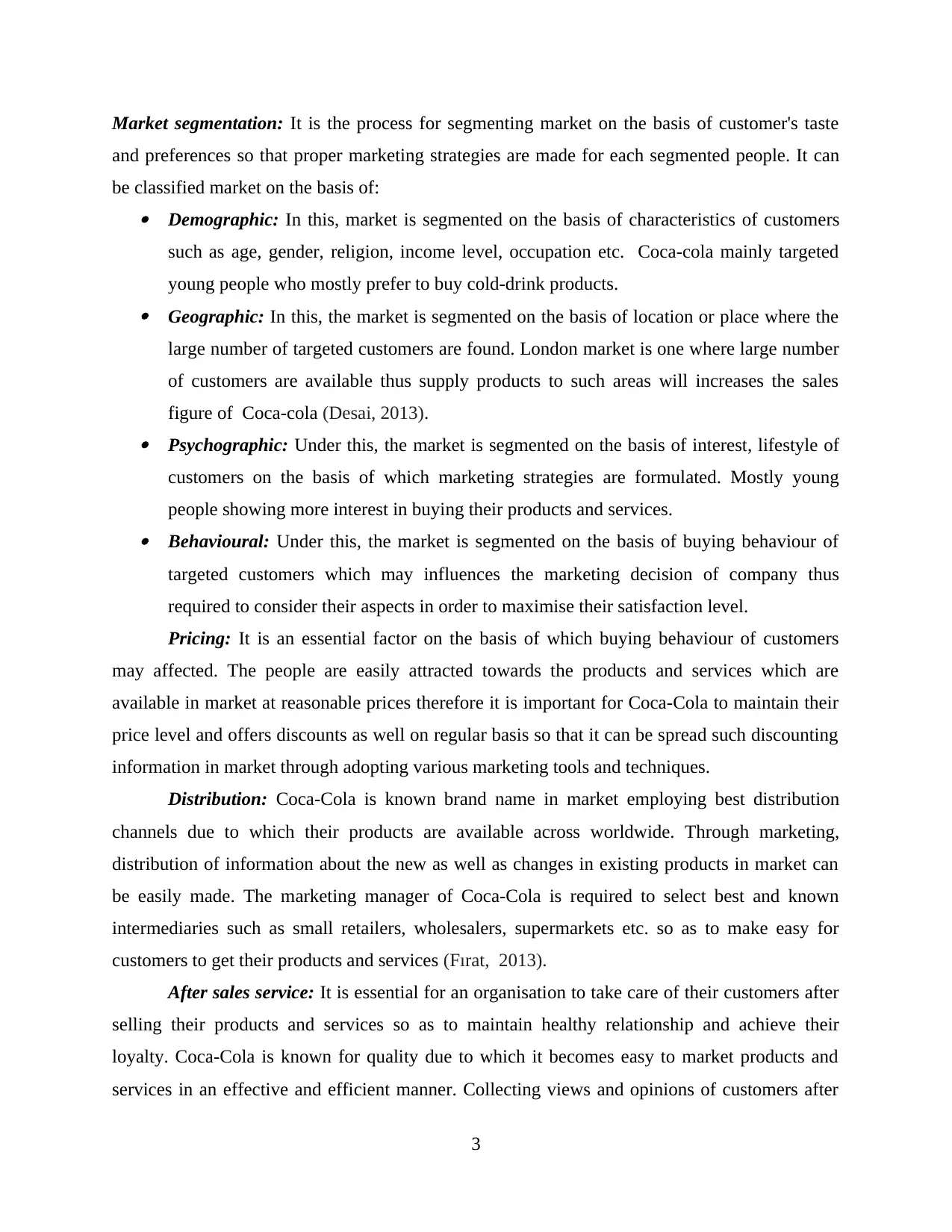
Market segmentation: It is the process for segmenting market on the basis of customer's taste
and preferences so that proper marketing strategies are made for each segmented people. It can
be classified market on the basis of: Demographic: In this, market is segmented on the basis of characteristics of customers
such as age, gender, religion, income level, occupation etc. Coca-cola mainly targeted
young people who mostly prefer to buy cold-drink products. Geographic: In this, the market is segmented on the basis of location or place where the
large number of targeted customers are found. London market is one where large number
of customers are available thus supply products to such areas will increases the sales
figure of Coca-cola (Desai, 2013). Psychographic: Under this, the market is segmented on the basis of interest, lifestyle of
customers on the basis of which marketing strategies are formulated. Mostly young
people showing more interest in buying their products and services. Behavioural: Under this, the market is segmented on the basis of buying behaviour of
targeted customers which may influences the marketing decision of company thus
required to consider their aspects in order to maximise their satisfaction level.
Pricing: It is an essential factor on the basis of which buying behaviour of customers
may affected. The people are easily attracted towards the products and services which are
available in market at reasonable prices therefore it is important for Coca-Cola to maintain their
price level and offers discounts as well on regular basis so that it can be spread such discounting
information in market through adopting various marketing tools and techniques.
Distribution: Coca-Cola is known brand name in market employing best distribution
channels due to which their products are available across worldwide. Through marketing,
distribution of information about the new as well as changes in existing products in market can
be easily made. The marketing manager of Coca-Cola is required to select best and known
intermediaries such as small retailers, wholesalers, supermarkets etc. so as to make easy for
customers to get their products and services (Fırat, 2013).
After sales service: It is essential for an organisation to take care of their customers after
selling their products and services so as to maintain healthy relationship and achieve their
loyalty. Coca-Cola is known for quality due to which it becomes easy to market products and
services in an effective and efficient manner. Collecting views and opinions of customers after
3
and preferences so that proper marketing strategies are made for each segmented people. It can
be classified market on the basis of: Demographic: In this, market is segmented on the basis of characteristics of customers
such as age, gender, religion, income level, occupation etc. Coca-cola mainly targeted
young people who mostly prefer to buy cold-drink products. Geographic: In this, the market is segmented on the basis of location or place where the
large number of targeted customers are found. London market is one where large number
of customers are available thus supply products to such areas will increases the sales
figure of Coca-cola (Desai, 2013). Psychographic: Under this, the market is segmented on the basis of interest, lifestyle of
customers on the basis of which marketing strategies are formulated. Mostly young
people showing more interest in buying their products and services. Behavioural: Under this, the market is segmented on the basis of buying behaviour of
targeted customers which may influences the marketing decision of company thus
required to consider their aspects in order to maximise their satisfaction level.
Pricing: It is an essential factor on the basis of which buying behaviour of customers
may affected. The people are easily attracted towards the products and services which are
available in market at reasonable prices therefore it is important for Coca-Cola to maintain their
price level and offers discounts as well on regular basis so that it can be spread such discounting
information in market through adopting various marketing tools and techniques.
Distribution: Coca-Cola is known brand name in market employing best distribution
channels due to which their products are available across worldwide. Through marketing,
distribution of information about the new as well as changes in existing products in market can
be easily made. The marketing manager of Coca-Cola is required to select best and known
intermediaries such as small retailers, wholesalers, supermarkets etc. so as to make easy for
customers to get their products and services (Fırat, 2013).
After sales service: It is essential for an organisation to take care of their customers after
selling their products and services so as to maintain healthy relationship and achieve their
loyalty. Coca-Cola is known for quality due to which it becomes easy to market products and
services in an effective and efficient manner. Collecting views and opinions of customers after
3
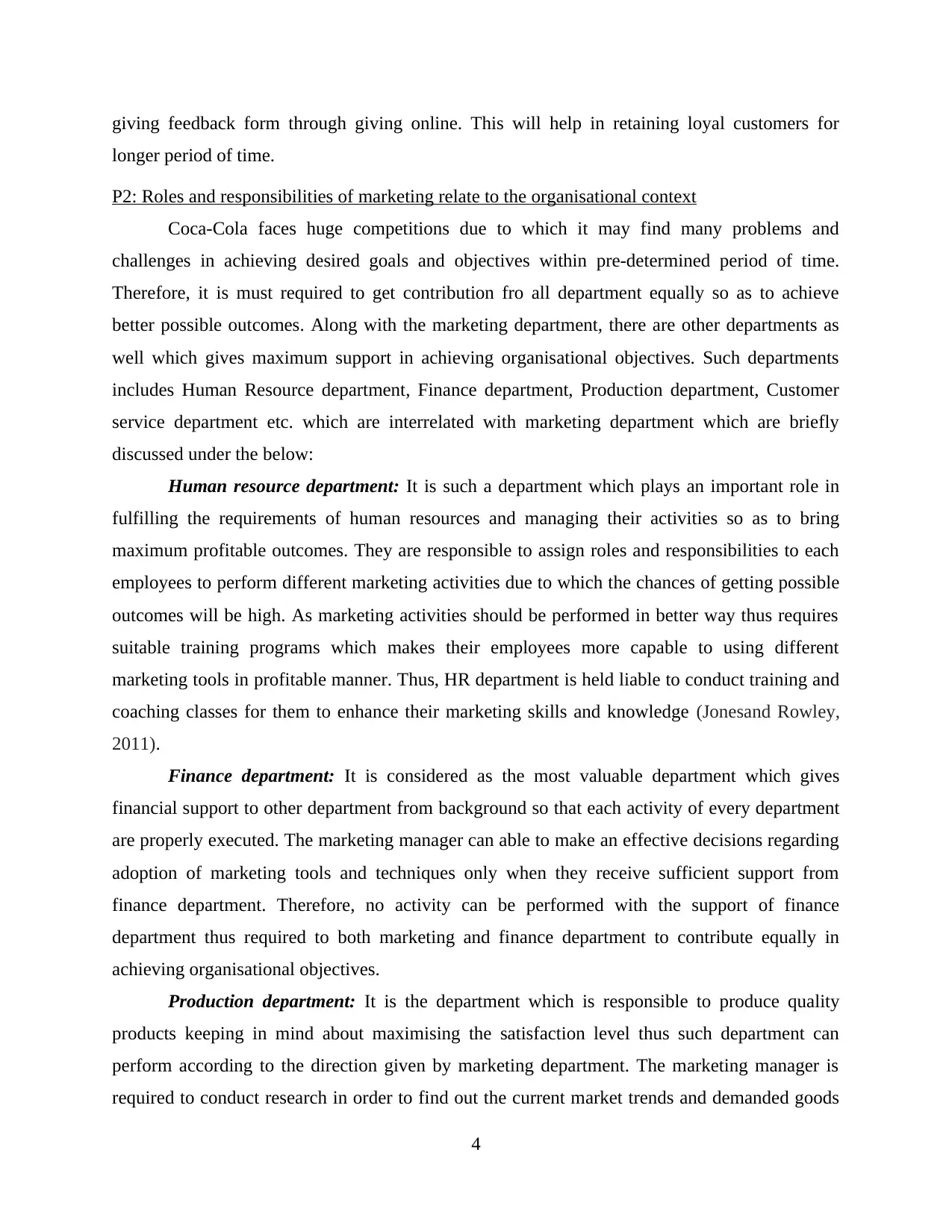
giving feedback form through giving online. This will help in retaining loyal customers for
longer period of time.
P2: Roles and responsibilities of marketing relate to the organisational context
Coca-Cola faces huge competitions due to which it may find many problems and
challenges in achieving desired goals and objectives within pre-determined period of time.
Therefore, it is must required to get contribution fro all department equally so as to achieve
better possible outcomes. Along with the marketing department, there are other departments as
well which gives maximum support in achieving organisational objectives. Such departments
includes Human Resource department, Finance department, Production department, Customer
service department etc. which are interrelated with marketing department which are briefly
discussed under the below:
Human resource department: It is such a department which plays an important role in
fulfilling the requirements of human resources and managing their activities so as to bring
maximum profitable outcomes. They are responsible to assign roles and responsibilities to each
employees to perform different marketing activities due to which the chances of getting possible
outcomes will be high. As marketing activities should be performed in better way thus requires
suitable training programs which makes their employees more capable to using different
marketing tools in profitable manner. Thus, HR department is held liable to conduct training and
coaching classes for them to enhance their marketing skills and knowledge (Jonesand Rowley,
2011).
Finance department: It is considered as the most valuable department which gives
financial support to other department from background so that each activity of every department
are properly executed. The marketing manager can able to make an effective decisions regarding
adoption of marketing tools and techniques only when they receive sufficient support from
finance department. Therefore, no activity can be performed with the support of finance
department thus required to both marketing and finance department to contribute equally in
achieving organisational objectives.
Production department: It is the department which is responsible to produce quality
products keeping in mind about maximising the satisfaction level thus such department can
perform according to the direction given by marketing department. The marketing manager is
required to conduct research in order to find out the current market trends and demanded goods
4
longer period of time.
P2: Roles and responsibilities of marketing relate to the organisational context
Coca-Cola faces huge competitions due to which it may find many problems and
challenges in achieving desired goals and objectives within pre-determined period of time.
Therefore, it is must required to get contribution fro all department equally so as to achieve
better possible outcomes. Along with the marketing department, there are other departments as
well which gives maximum support in achieving organisational objectives. Such departments
includes Human Resource department, Finance department, Production department, Customer
service department etc. which are interrelated with marketing department which are briefly
discussed under the below:
Human resource department: It is such a department which plays an important role in
fulfilling the requirements of human resources and managing their activities so as to bring
maximum profitable outcomes. They are responsible to assign roles and responsibilities to each
employees to perform different marketing activities due to which the chances of getting possible
outcomes will be high. As marketing activities should be performed in better way thus requires
suitable training programs which makes their employees more capable to using different
marketing tools in profitable manner. Thus, HR department is held liable to conduct training and
coaching classes for them to enhance their marketing skills and knowledge (Jonesand Rowley,
2011).
Finance department: It is considered as the most valuable department which gives
financial support to other department from background so that each activity of every department
are properly executed. The marketing manager can able to make an effective decisions regarding
adoption of marketing tools and techniques only when they receive sufficient support from
finance department. Therefore, no activity can be performed with the support of finance
department thus required to both marketing and finance department to contribute equally in
achieving organisational objectives.
Production department: It is the department which is responsible to produce quality
products keeping in mind about maximising the satisfaction level thus such department can
perform according to the direction given by marketing department. The marketing manager is
required to conduct research in order to find out the current market trends and demanded goods
4
⊘ This is a preview!⊘
Do you want full access?
Subscribe today to unlock all pages.

Trusted by 1+ million students worldwide
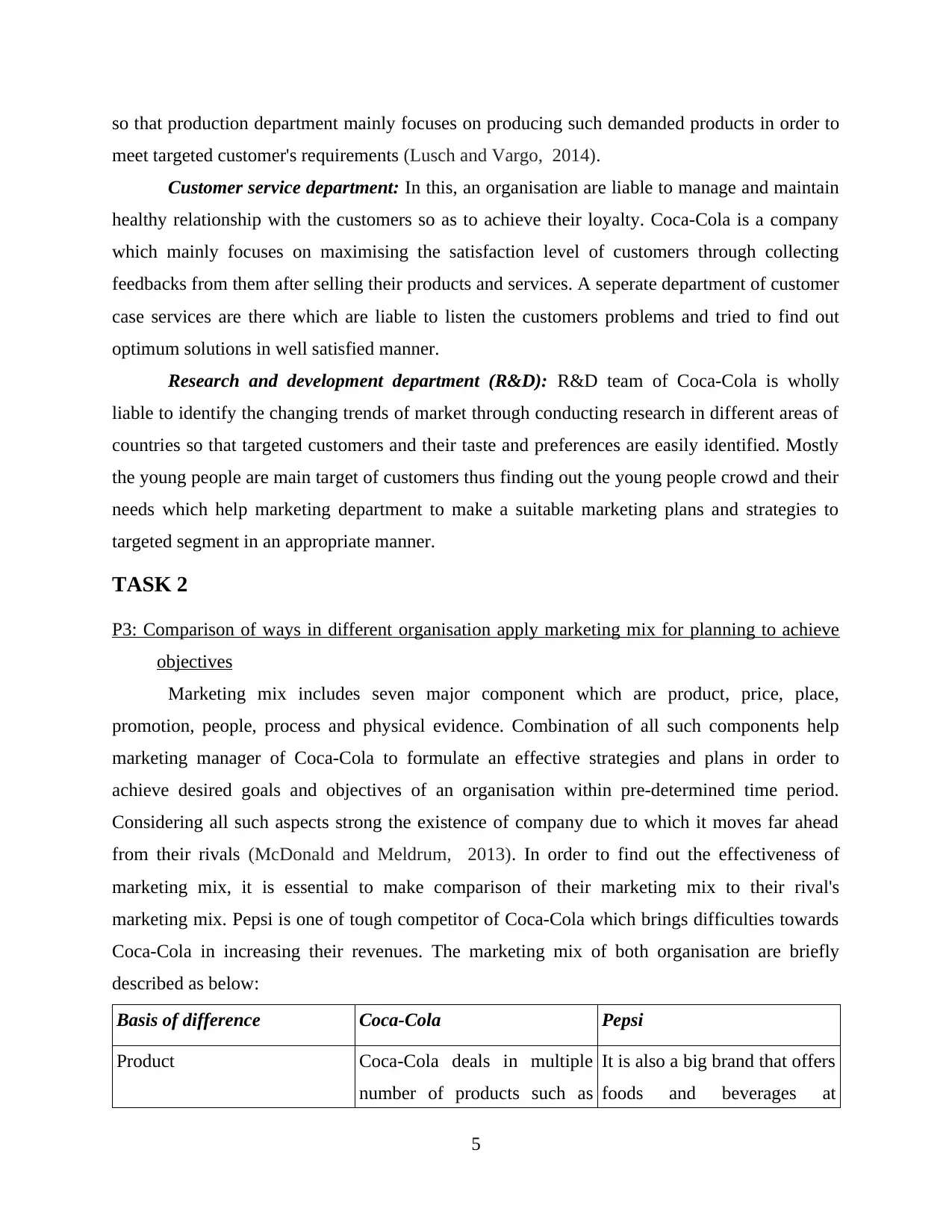
so that production department mainly focuses on producing such demanded products in order to
meet targeted customer's requirements (Lusch and Vargo, 2014).
Customer service department: In this, an organisation are liable to manage and maintain
healthy relationship with the customers so as to achieve their loyalty. Coca-Cola is a company
which mainly focuses on maximising the satisfaction level of customers through collecting
feedbacks from them after selling their products and services. A seperate department of customer
case services are there which are liable to listen the customers problems and tried to find out
optimum solutions in well satisfied manner.
Research and development department (R&D): R&D team of Coca-Cola is wholly
liable to identify the changing trends of market through conducting research in different areas of
countries so that targeted customers and their taste and preferences are easily identified. Mostly
the young people are main target of customers thus finding out the young people crowd and their
needs which help marketing department to make a suitable marketing plans and strategies to
targeted segment in an appropriate manner.
TASK 2
P3: Comparison of ways in different organisation apply marketing mix for planning to achieve
objectives
Marketing mix includes seven major component which are product, price, place,
promotion, people, process and physical evidence. Combination of all such components help
marketing manager of Coca-Cola to formulate an effective strategies and plans in order to
achieve desired goals and objectives of an organisation within pre-determined time period.
Considering all such aspects strong the existence of company due to which it moves far ahead
from their rivals (McDonald and Meldrum, 2013). In order to find out the effectiveness of
marketing mix, it is essential to make comparison of their marketing mix to their rival's
marketing mix. Pepsi is one of tough competitor of Coca-Cola which brings difficulties towards
Coca-Cola in increasing their revenues. The marketing mix of both organisation are briefly
described as below:
Basis of difference Coca-Cola Pepsi
Product Coca-Cola deals in multiple
number of products such as
It is also a big brand that offers
foods and beverages at
5
meet targeted customer's requirements (Lusch and Vargo, 2014).
Customer service department: In this, an organisation are liable to manage and maintain
healthy relationship with the customers so as to achieve their loyalty. Coca-Cola is a company
which mainly focuses on maximising the satisfaction level of customers through collecting
feedbacks from them after selling their products and services. A seperate department of customer
case services are there which are liable to listen the customers problems and tried to find out
optimum solutions in well satisfied manner.
Research and development department (R&D): R&D team of Coca-Cola is wholly
liable to identify the changing trends of market through conducting research in different areas of
countries so that targeted customers and their taste and preferences are easily identified. Mostly
the young people are main target of customers thus finding out the young people crowd and their
needs which help marketing department to make a suitable marketing plans and strategies to
targeted segment in an appropriate manner.
TASK 2
P3: Comparison of ways in different organisation apply marketing mix for planning to achieve
objectives
Marketing mix includes seven major component which are product, price, place,
promotion, people, process and physical evidence. Combination of all such components help
marketing manager of Coca-Cola to formulate an effective strategies and plans in order to
achieve desired goals and objectives of an organisation within pre-determined time period.
Considering all such aspects strong the existence of company due to which it moves far ahead
from their rivals (McDonald and Meldrum, 2013). In order to find out the effectiveness of
marketing mix, it is essential to make comparison of their marketing mix to their rival's
marketing mix. Pepsi is one of tough competitor of Coca-Cola which brings difficulties towards
Coca-Cola in increasing their revenues. The marketing mix of both organisation are briefly
described as below:
Basis of difference Coca-Cola Pepsi
Product Coca-Cola deals in multiple
number of products such as
It is also a big brand that offers
foods and beverages at
5
Paraphrase This Document
Need a fresh take? Get an instant paraphrase of this document with our AI Paraphraser
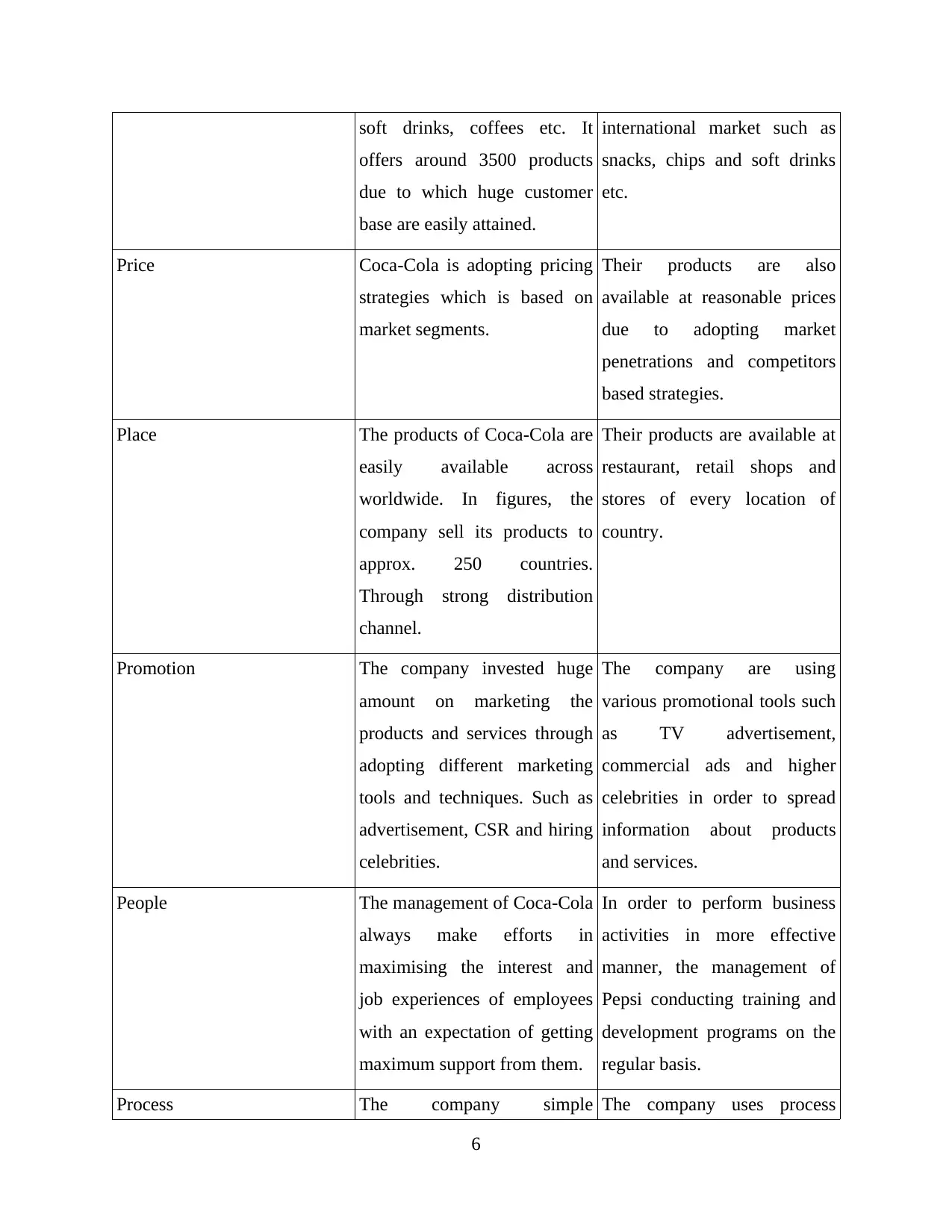
soft drinks, coffees etc. It
offers around 3500 products
due to which huge customer
base are easily attained.
international market such as
snacks, chips and soft drinks
etc.
Price Coca-Cola is adopting pricing
strategies which is based on
market segments.
Their products are also
available at reasonable prices
due to adopting market
penetrations and competitors
based strategies.
Place The products of Coca-Cola are
easily available across
worldwide. In figures, the
company sell its products to
approx. 250 countries.
Through strong distribution
channel.
Their products are available at
restaurant, retail shops and
stores of every location of
country.
Promotion The company invested huge
amount on marketing the
products and services through
adopting different marketing
tools and techniques. Such as
advertisement, CSR and hiring
celebrities.
The company are using
various promotional tools such
as TV advertisement,
commercial ads and higher
celebrities in order to spread
information about products
and services.
People The management of Coca-Cola
always make efforts in
maximising the interest and
job experiences of employees
with an expectation of getting
maximum support from them.
In order to perform business
activities in more effective
manner, the management of
Pepsi conducting training and
development programs on the
regular basis.
Process The company simple The company uses process
6
offers around 3500 products
due to which huge customer
base are easily attained.
international market such as
snacks, chips and soft drinks
etc.
Price Coca-Cola is adopting pricing
strategies which is based on
market segments.
Their products are also
available at reasonable prices
due to adopting market
penetrations and competitors
based strategies.
Place The products of Coca-Cola are
easily available across
worldwide. In figures, the
company sell its products to
approx. 250 countries.
Through strong distribution
channel.
Their products are available at
restaurant, retail shops and
stores of every location of
country.
Promotion The company invested huge
amount on marketing the
products and services through
adopting different marketing
tools and techniques. Such as
advertisement, CSR and hiring
celebrities.
The company are using
various promotional tools such
as TV advertisement,
commercial ads and higher
celebrities in order to spread
information about products
and services.
People The management of Coca-Cola
always make efforts in
maximising the interest and
job experiences of employees
with an expectation of getting
maximum support from them.
In order to perform business
activities in more effective
manner, the management of
Pepsi conducting training and
development programs on the
regular basis.
Process The company simple The company uses process
6
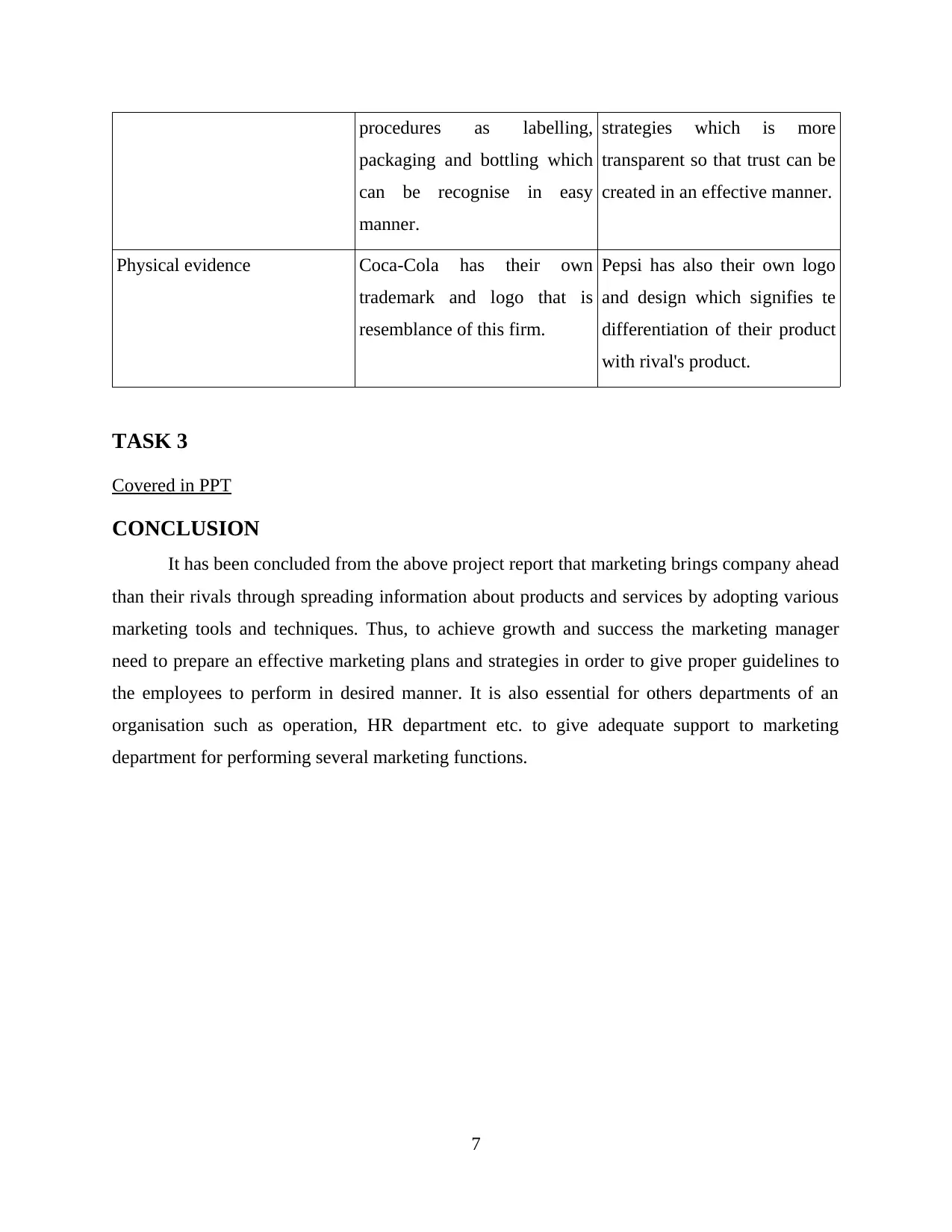
procedures as labelling,
packaging and bottling which
can be recognise in easy
manner.
strategies which is more
transparent so that trust can be
created in an effective manner.
Physical evidence Coca-Cola has their own
trademark and logo that is
resemblance of this firm.
Pepsi has also their own logo
and design which signifies te
differentiation of their product
with rival's product.
TASK 3
Covered in PPT
CONCLUSION
It has been concluded from the above project report that marketing brings company ahead
than their rivals through spreading information about products and services by adopting various
marketing tools and techniques. Thus, to achieve growth and success the marketing manager
need to prepare an effective marketing plans and strategies in order to give proper guidelines to
the employees to perform in desired manner. It is also essential for others departments of an
organisation such as operation, HR department etc. to give adequate support to marketing
department for performing several marketing functions.
7
packaging and bottling which
can be recognise in easy
manner.
strategies which is more
transparent so that trust can be
created in an effective manner.
Physical evidence Coca-Cola has their own
trademark and logo that is
resemblance of this firm.
Pepsi has also their own logo
and design which signifies te
differentiation of their product
with rival's product.
TASK 3
Covered in PPT
CONCLUSION
It has been concluded from the above project report that marketing brings company ahead
than their rivals through spreading information about products and services by adopting various
marketing tools and techniques. Thus, to achieve growth and success the marketing manager
need to prepare an effective marketing plans and strategies in order to give proper guidelines to
the employees to perform in desired manner. It is also essential for others departments of an
organisation such as operation, HR department etc. to give adequate support to marketing
department for performing several marketing functions.
7
⊘ This is a preview!⊘
Do you want full access?
Subscribe today to unlock all pages.

Trusted by 1+ million students worldwide
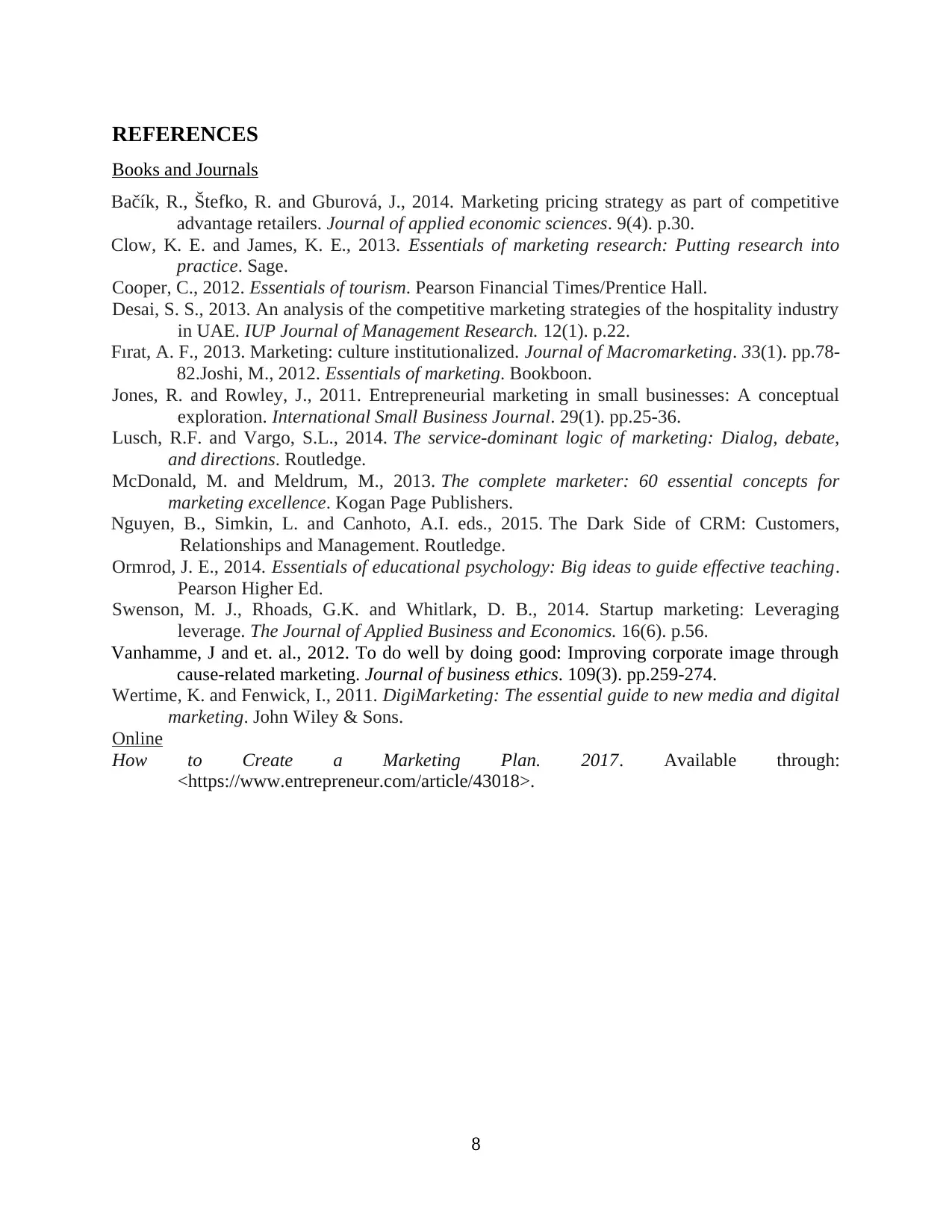
REFERENCES
Books and Journals
Bačík, R., Štefko, R. and Gburová, J., 2014. Marketing pricing strategy as part of competitive
advantage retailers. Journal of applied economic sciences. 9(4). p.30.
Clow, K. E. and James, K. E., 2013. Essentials of marketing research: Putting research into
practice. Sage.
Cooper, C., 2012. Essentials of tourism. Pearson Financial Times/Prentice Hall.
Desai, S. S., 2013. An analysis of the competitive marketing strategies of the hospitality industry
in UAE. IUP Journal of Management Research. 12(1). p.22.
Fırat, A. F., 2013. Marketing: culture institutionalized. Journal of Macromarketing. 33(1). pp.78-
82.Joshi, M., 2012. Essentials of marketing. Bookboon.
Jones, R. and Rowley, J., 2011. Entrepreneurial marketing in small businesses: A conceptual
exploration. International Small Business Journal. 29(1). pp.25-36.
Lusch, R.F. and Vargo, S.L., 2014. The service-dominant logic of marketing: Dialog, debate,
and directions. Routledge.
McDonald, M. and Meldrum, M., 2013. The complete marketer: 60 essential concepts for
marketing excellence. Kogan Page Publishers.
Nguyen, B., Simkin, L. and Canhoto, A.I. eds., 2015. The Dark Side of CRM: Customers,
Relationships and Management. Routledge.
Ormrod, J. E., 2014. Essentials of educational psychology: Big ideas to guide effective teaching.
Pearson Higher Ed.
Swenson, M. J., Rhoads, G.K. and Whitlark, D. B., 2014. Startup marketing: Leveraging
leverage. The Journal of Applied Business and Economics. 16(6). p.56.
Vanhamme, J and et. al., 2012. To do well by doing good: Improving corporate image through
cause-related marketing. Journal of business ethics. 109(3). pp.259-274.
Wertime, K. and Fenwick, I., 2011. DigiMarketing: The essential guide to new media and digital
marketing. John Wiley & Sons.
Online
How to Create a Marketing Plan. 2017. Available through:
<https://www.entrepreneur.com/article/43018>.
8
Books and Journals
Bačík, R., Štefko, R. and Gburová, J., 2014. Marketing pricing strategy as part of competitive
advantage retailers. Journal of applied economic sciences. 9(4). p.30.
Clow, K. E. and James, K. E., 2013. Essentials of marketing research: Putting research into
practice. Sage.
Cooper, C., 2012. Essentials of tourism. Pearson Financial Times/Prentice Hall.
Desai, S. S., 2013. An analysis of the competitive marketing strategies of the hospitality industry
in UAE. IUP Journal of Management Research. 12(1). p.22.
Fırat, A. F., 2013. Marketing: culture institutionalized. Journal of Macromarketing. 33(1). pp.78-
82.Joshi, M., 2012. Essentials of marketing. Bookboon.
Jones, R. and Rowley, J., 2011. Entrepreneurial marketing in small businesses: A conceptual
exploration. International Small Business Journal. 29(1). pp.25-36.
Lusch, R.F. and Vargo, S.L., 2014. The service-dominant logic of marketing: Dialog, debate,
and directions. Routledge.
McDonald, M. and Meldrum, M., 2013. The complete marketer: 60 essential concepts for
marketing excellence. Kogan Page Publishers.
Nguyen, B., Simkin, L. and Canhoto, A.I. eds., 2015. The Dark Side of CRM: Customers,
Relationships and Management. Routledge.
Ormrod, J. E., 2014. Essentials of educational psychology: Big ideas to guide effective teaching.
Pearson Higher Ed.
Swenson, M. J., Rhoads, G.K. and Whitlark, D. B., 2014. Startup marketing: Leveraging
leverage. The Journal of Applied Business and Economics. 16(6). p.56.
Vanhamme, J and et. al., 2012. To do well by doing good: Improving corporate image through
cause-related marketing. Journal of business ethics. 109(3). pp.259-274.
Wertime, K. and Fenwick, I., 2011. DigiMarketing: The essential guide to new media and digital
marketing. John Wiley & Sons.
Online
How to Create a Marketing Plan. 2017. Available through:
<https://www.entrepreneur.com/article/43018>.
8
1 out of 10
Related Documents
Your All-in-One AI-Powered Toolkit for Academic Success.
+13062052269
info@desklib.com
Available 24*7 on WhatsApp / Email
![[object Object]](/_next/static/media/star-bottom.7253800d.svg)
Unlock your academic potential
Copyright © 2020–2025 A2Z Services. All Rights Reserved. Developed and managed by ZUCOL.





